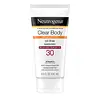What's inside
What's inside
 Key Ingredients
Key Ingredients

 Benefits
Benefits

 Concerns
Concerns

 Ingredients Side-by-side
Ingredients Side-by-side

Water
Skin ConditioningOctocrylene
UV AbsorberEthylhexyl Salicylate
UV AbsorberGlycerin
HumectantGlyceryl Montanate
EmulsifyingCetyl Alcohol
EmollientCetearyl Alcohol
EmollientEmulsifying Wax Nf
Acrylates Crosspolymer
AbsorbentMethylene Bis-Benzotriazolyl Tetramethylbutylphenol
UV FilterSqualane
EmollientOzonized Sesame Seed Oil
Skin ConditioningCarthamus Tinctorius Seed Oil
MaskingIsopropyl Palmitate
EmollientNiacinamide
SmoothingCamellia Sinensis Leaf Extract
AntimicrobialXanthan Gum
EmulsifyingHydroxyethylcellulose
Emulsion StabilisingPhenoxyethanol
PreservativeEthylhexylglycerin
Skin ConditioningPotassium Sorbate
PreservativeSodium Benzoate
MaskingCitric Acid
BufferingWater, Octocrylene, Ethylhexyl Salicylate, Glycerin, Glyceryl Montanate, Cetyl Alcohol, Cetearyl Alcohol, Emulsifying Wax Nf, Acrylates Crosspolymer, Methylene Bis-Benzotriazolyl Tetramethylbutylphenol, Squalane, Ozonized Sesame Seed Oil, Carthamus Tinctorius Seed Oil, Isopropyl Palmitate, Niacinamide, Camellia Sinensis Leaf Extract, Xanthan Gum, Hydroxyethylcellulose, Phenoxyethanol, Ethylhexylglycerin, Potassium Sorbate, Sodium Benzoate, Citric Acid
Butyl Methoxydibenzoylmethane 2.5%
UV AbsorberHomosalate 8%
Skin ConditioningEthylhexyl Salicylate 5%
UV AbsorberOctocrylene 8%
UV AbsorberWater
Skin ConditioningSilica
AbrasiveCetyl Dimethicone
EmollientStyrene/Acrylates Copolymer
C12-15 Alkyl Benzoate
AntimicrobialEthylhexylglycerin
Skin ConditioningSteareth-100
Gel FormingAluminum Starch Octenylsuccinate
AbsorbentPhenoxyethanol
PreservativeCaprylyl Glycol
EmollientSodium Polyacrylate
AbsorbentDimethicone
EmollientPolyester-7
Skin ConditioningChlorphenesin
AntimicrobialSteareth-2
EmulsifyingEthylhexyl Stearate
EmollientDisodium EDTA
Propylene Glycol
HumectantNeopentyl Glycol Diheptanoate
EmollientBisabolol
MaskingAcrylates/Dimethicone Copolymer
Skin ConditioningButylene Glycol
HumectantBHT
AntioxidantMannan
Xanthan Gum
EmulsifyingCapryloyl Glycine
CleansingTrideceth-6
EmulsifyingSarcosine
Skin ConditioningCedrus Atlantica Bark Extract
PerfumingCinnamomum Zeylanicum Bark Extract
AntimicrobialPortulaca Oleracea Extract
Skin ConditioningButyl Methoxydibenzoylmethane 2.5%, Homosalate 8%, Ethylhexyl Salicylate 5%, Octocrylene 8%, Water, Silica, Cetyl Dimethicone, Styrene/Acrylates Copolymer, C12-15 Alkyl Benzoate, Ethylhexylglycerin, Steareth-100, Aluminum Starch Octenylsuccinate, Phenoxyethanol, Caprylyl Glycol, Sodium Polyacrylate, Dimethicone, Polyester-7, Chlorphenesin, Steareth-2, Ethylhexyl Stearate, Disodium EDTA, Propylene Glycol, Neopentyl Glycol Diheptanoate, Bisabolol, Acrylates/Dimethicone Copolymer, Butylene Glycol, BHT, Mannan, Xanthan Gum, Capryloyl Glycine, Trideceth-6, Sarcosine, Cedrus Atlantica Bark Extract, Cinnamomum Zeylanicum Bark Extract, Portulaca Oleracea Extract
Ingredients Explained
These ingredients are found in both products.
Ingredients higher up in an ingredient list are typically present in a larger amount.
Ethylhexyl Salicylate is an organic compound used to block UV rays. It primarily absorbs UVB rays but offers a small amount of UVA protection as well.
Commonly found in sunscreens, Ethylhexyl Salicylate is created from salicylic acid and 2-ethylhexanol. You might know salicylic acid as the effective acne fighter ingredient and BHA.
The ethylhexanol in this ingredient is a fatty alcohol and helps hydrate your skin, similar to oils. It is an emollient, which means it traps moisture into the skin.
According to manufacturers, Ethylhexyl Salicylate absorbs UV wavelength of 295-315 nm, with a peak absorption at 307-310 nm. UVA rays are linked to long term skin damage, such as hyperpigmentation. UVB rays emit more energy and are capable of damaging our DNA. UVB rays cause sunburn.
Learn more about Ethylhexyl SalicylateEthylhexylglycerin (we can't pronounce this either) is commonly used as a preservative and skin softener. It is derived from glyceryl.
You might see Ethylhexylglycerin often paired with other preservatives such as phenoxyethanol. Ethylhexylglycerin has been found to increase the effectiveness of these other preservatives.
Octocrylene protects skin from sun damage. It absorbs UV-B with peak absorption of 304 nm. It is a common sunscreen ingredient and often paired with avobenzone, a UVA filter. This is because octocrylene stabilizes other sunscreen ingredients by protecting them from degradation when exposed to sunlight. Octocrylene is a photostable ingredient and loses about 10% of SPF in 95 minutes.
Octocrylene also acts as an emollient, meaning it helps skin retain moisture and softens skin. It is oil-soluble and hydrophobic, enhancing water-resistant properties in a product.
Those who are using ketoprofen, a topical anti-inflammatory drug, may experience an allergic reaction when using octocrylene. It is best to speak with a healthcare professional about using sunscreens with octocrylene.
The EU allows a maximum of these concentrations:
Learn more about OctocrylenePhenoxyethanol is a preservative that has germicide, antimicrobial, and aromatic properties. Studies show that phenoxyethanol can prevent microbial growth. By itself, it has a scent that is similar to that of a rose.
It's often used in formulations along with Caprylyl Glycol to preserve the shelf life of products.
Water. It's the most common cosmetic ingredient of all. You'll usually see it at the top of ingredient lists, meaning that it makes up the largest part of the product.
So why is it so popular? Water most often acts as a solvent - this means that it helps dissolve other ingredients into the formulation.
You'll also recognize water as that liquid we all need to stay alive. If you see this, drink a glass of water. Stay hydrated!
Learn more about WaterXanthan gum is used as a stabilizer and thickener within cosmetic products. It helps give products a sticky, thick feeling - preventing them from being too runny.
On the technical side of things, xanthan gum is a polysaccharide - a combination consisting of multiple sugar molecules bonded together.
Xanthan gum is a pretty common and great ingredient. It is a natural, non-toxic, non-irritating ingredient that is also commonly used in food products.
Learn more about Xanthan Gum